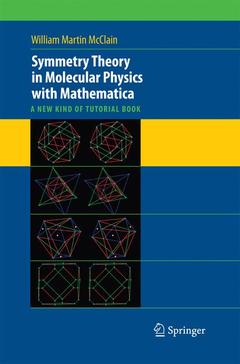Description
Symmetry Theory in Molecular Physics with Mathematica, 2008
A new kind of tutorial book
Author: McClain William
Language: English
Subject for Symmetry Theory in Molecular Physics with Mathematica:
Publication date: 11-2014
689 p. · 15.5x23.5 cm · Paperback
Approximative price 104.44 €
Subject to availability at the publisher.
Add to cartPublication date: 09-2009
Support: CD
Description
/li>Contents
/li>Biography
/li>Comment
/li>
Prof. McClain has, quite simply, produced a new kind of tutorial book. It is written using the logic engine Mathematica, which permits concrete exploration and development of every concept involved in Symmetry Theory. It is aimed at students of chemistry and molecular physics who need to know mathematical group theory and its applications, either for their own research or for understanding the language and concepts of their field. The book begins with the most elementary symmetry concepts, then presents mathematical group theory, and finally the projection operators that flow from the Great Orthogonality are automated and applied to chemical and spectroscopic problems.
Culminates with chapters that use permutation groups to analyze flexible molecules, a topic which is on the frontier of current research and is not covered in any commonly adopted textbook
Makes use of modern methods of Mathematica to develop the subject of group theory as applied to molecular structure and to automate the complicated and tedious calculations involved
Begins with careful definitions of symmetry and group, and then proceeds to an explicit proof that symmetry transforms always come in groups - the basic explanation of why group theory helps with the study of symmetry
Includes supplementary material: sn.pub/extras




